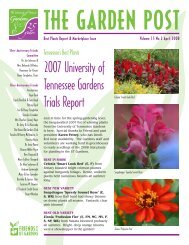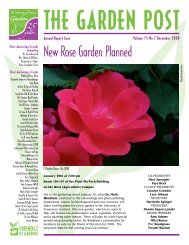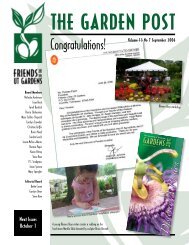Fall|Winter 2012-13 - UT Gardens - The University of Tennessee
Fall|Winter 2012-13 - UT Gardens - The University of Tennessee
Fall|Winter 2012-13 - UT Gardens - The University of Tennessee
You also want an ePaper? Increase the reach of your titles
YUMPU automatically turns print PDFs into web optimized ePapers that Google loves.
Tender Garden Plants<br />
By Hugh Conlon, <strong>UT</strong> Extension area specialist (retired)<br />
Is there frost on your pumpkins Cooler temperatures, shorter days and beautiful fall foliage are clear signs<br />
that it is time to take action and protect your tender plants before the winter season arrives. In October,<br />
many <strong>Tennessee</strong> gardeners turn their attention to protecting leafy and flowering tropicals such as cannas<br />
(Canna), gladiolas (Gladiolus), bananas (Musa and Ensete), elephant ears (Colocasia and Alocasia), caladiums<br />
(Caladium), and angel’s trumpets (Brugmansia).<br />
Favorite Annuals, such as heirloom<br />
geraniums, colorful coleus and exotic<br />
begonias need to be brought inside. <strong>The</strong>se<br />
and many others may be easily rooted<br />
as vegetative cuttings in coarse sand or<br />
perlite. <strong>The</strong> cuttings are covered with a<br />
clear plastic bag. It should be opened<br />
(vented) every few days to reduce builtup<br />
humidity (water droplets) inside the<br />
bag. Recheck the progress <strong>of</strong> rooting and<br />
reseal the bag. <strong>The</strong> plastic may be removed<br />
once cuttings have rooted, usually within<br />
three to four weeks. Rooted plants may<br />
be potted in fresh potting mix and set in a<br />
sunny east or south window in your home,<br />
greenhouse or solarium over the winter.<br />
Additional cuttings may be rooted from<br />
these plants as winter draws to a close.<br />
Bulbs, roots and stems, such as<br />
cannas (rhizome), dahlias (tuber), gladiolas<br />
(corm) and elephant ears (tuber) are <strong>of</strong>ten<br />
hardy in many urban gardens across the<br />
state. For additional insurance, you may<br />
elect to cover over the plant crowns with<br />
4-5 inches <strong>of</strong> loose airy mulch such as<br />
pine needles. Do not use maple and<br />
sycamore leaves, which tend to pack<br />
down. Gardeners in the mountainous areas<br />
<strong>of</strong> <strong>Tennessee</strong> are less fortunate; cannas,<br />
elephant ears and some types <strong>of</strong> dahlias<br />
and gladiolas should be lifted from garden<br />
beds and stored in a protected area over<br />
the winter. Let foliage and stems die back<br />
naturally, allowing remaining nutrients to<br />
be absorbed by the bulbs. Any soil should<br />
be shaken away from the root mass. Plants<br />
grown in decorative containers can be<br />
left in their pots and stored in a protected<br />
area as well. For nonhardy bananas (Musa<br />
and Ensete), cut <strong>of</strong>f the foliage but do<br />
not cut back the trunk or stem, as the<br />
growing tip <strong>of</strong> the stem will produce next<br />
year’s leaves. Bananas can be left in their<br />
growing containers or dug and stored bare<br />
root. Angel’s trumpets can be treated the<br />
same as bananas: cut <strong>of</strong>f foliage, leave in<br />
growing containers, or store bare root if<br />
dug out <strong>of</strong> the garden. Note that caladiums,<br />
being a true tropical bulb, are not winter<br />
hardy. <strong>The</strong>y either need to be treated as<br />
annuals — allowed to be killed by freezing<br />
temperatures — or dug and stored indoors<br />
throughout the winter.<br />
Proper Storage, such as a sunroom or<br />
greenhouse, would be the ideal way to get<br />
tender plants through the winter without<br />
making them go dormant. If you don’t<br />
have a sunroom or greenhouse, then know<br />
that light is not necessary for any <strong>of</strong> these<br />
plants, since you will be forcing them to<br />
go dormant. A root cellar, crawl space or<br />
garage can be ideal for overwintering tender<br />
plants and bulbs, but wherever you store<br />
them, keep temperatures above freezing.<br />
Ideal temperatures for most tender plants<br />
is between 35 F and 45 F. Dug bulbs can<br />
be stored in mesh orange or onion bags, or<br />
packed lightly in dry peat moss. Plants left<br />
in decorative containers overwinter best if<br />
not allowed to totally dry out. Caladium<br />
bulbs need to be stored where temperatures<br />
will not fall below 60 F.<br />
In early March, awaken dormant containers<br />
<strong>of</strong> tender plants and bulbs you’ve been<br />
storing. First, move them indoors and<br />
treat them as house plants. Likely, they’ve<br />
already begun to sprout. Specifically,<br />
angel’s trumpets, elephant ears, cannas<br />
and nonhardy bananas may be restarted<br />
from dormancy. Replant or add any needed<br />
potting soil, prune <strong>of</strong>f old foliage, and<br />
begin a regular watering and fertilizing<br />
schedule. If you have no indoor growing<br />
space, continue to hold plants in limited<br />
dormancy until April when they can be<br />
moved outdoors. Keep an eye on nighttime<br />
temperatures until the chance <strong>of</strong> frost has<br />
passed; you may need to cover your plants<br />
with a cloth tarp during cold nights.<br />
<strong>Fall|Winter</strong> 12-<strong>13</strong> 15











